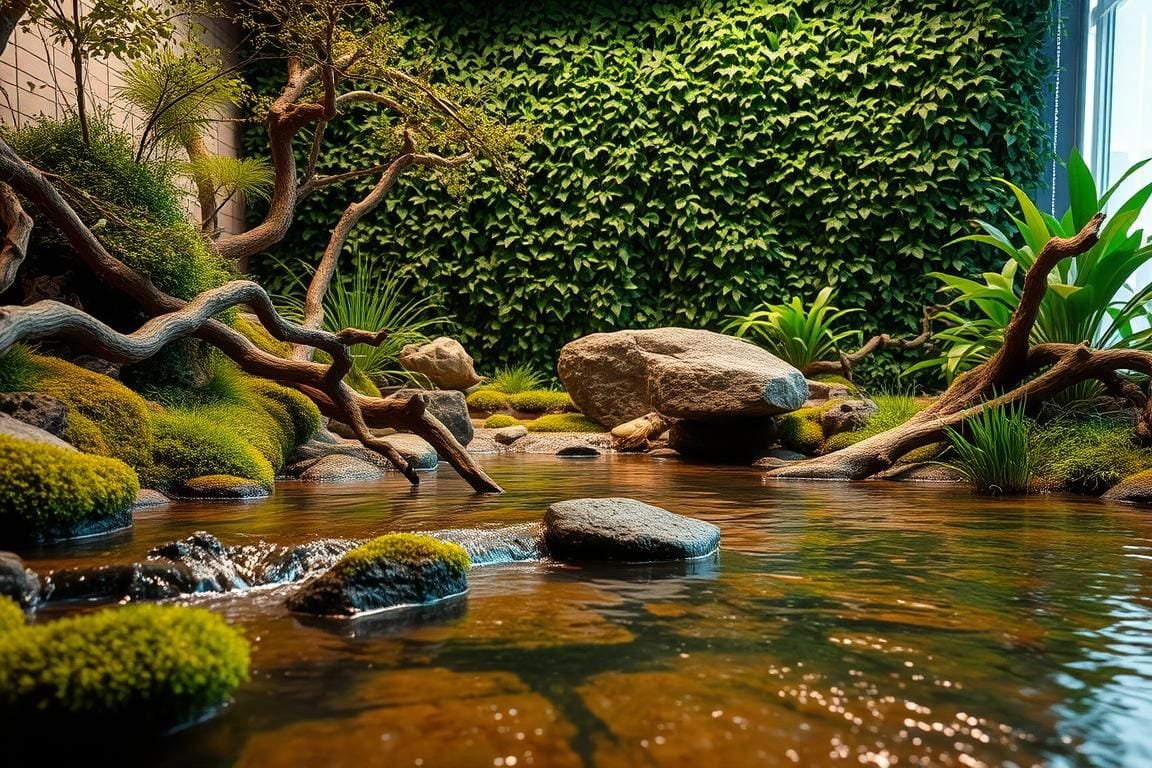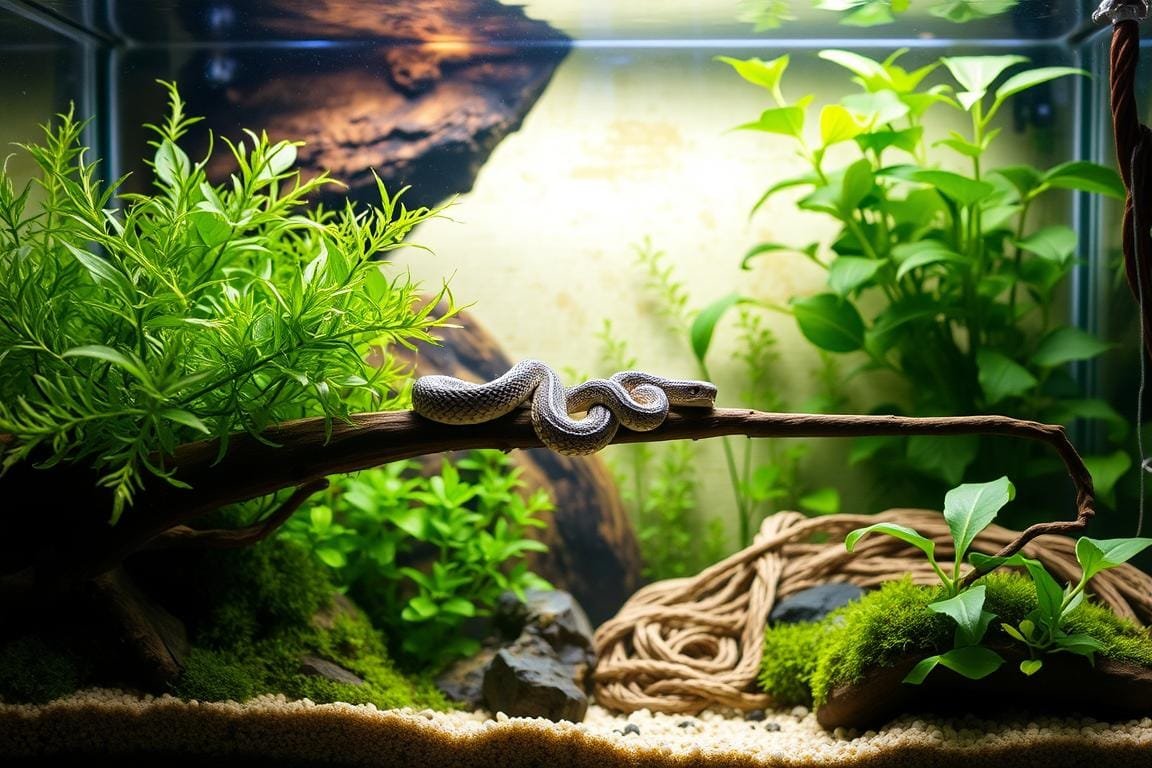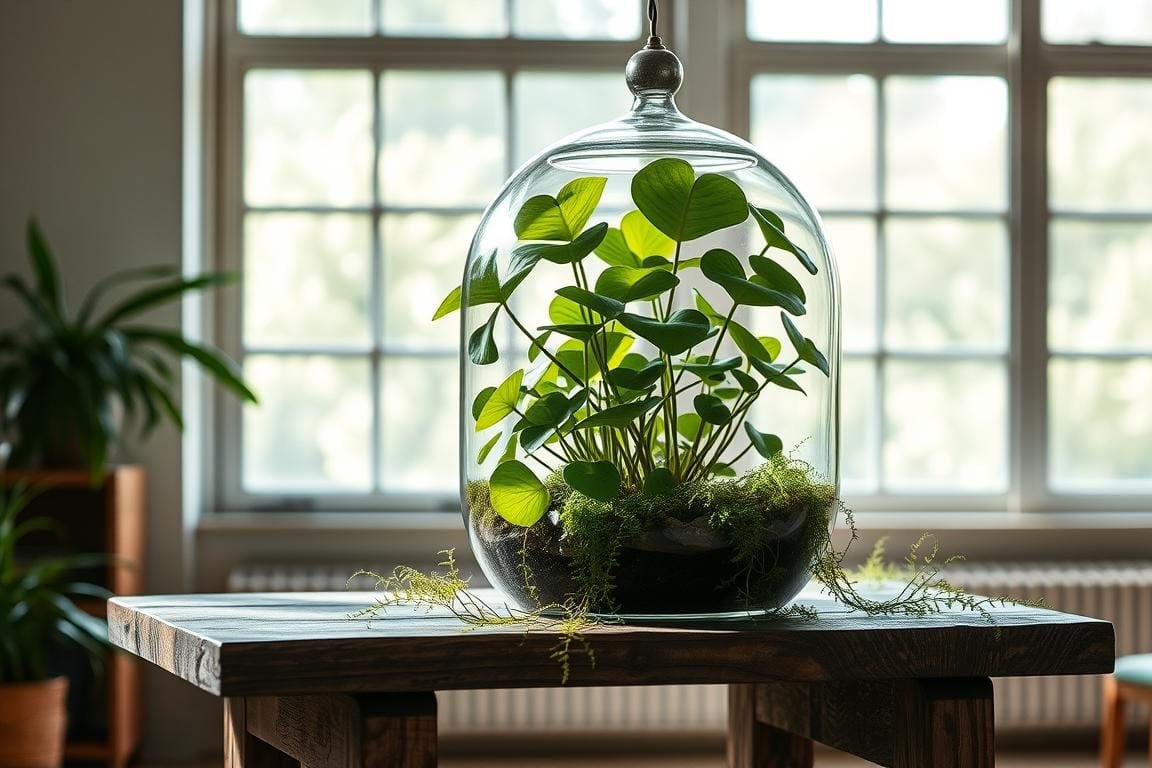Creating a thriving environment for your pet reptile starts with understanding its natural needs. These vibrant creatures originate from the lush forests and waterways of Southeast Asia, where humidity, warmth, and climbing opportunities shape their daily lives. Replicating these conditions at home isn’t just beneficial—it’s essential for their physical health and mental well-being.
A well-designed enclosure balances space, temperature, and enrichment. Basking zones must mimic sunlight patterns, while humidity levels should reflect tropical climates. Vertical space is equally important, as these agile reptiles love to climb and explore. Whether you choose a DIY project or a pre-built vivarium, prioritizing these elements ensures your pet feels at home.
This guide covers everything from heating systems to diet tips, helping you avoid common pitfalls. For detailed insights on enclosure design, check out our comprehensive walkthrough. Let’s create a space where your scaled companion can thrive for years to come!
Understanding the Natural History and Behavior of Chinese Water Dragons
To design a home that keeps your scaly friend healthy, start by learning how they live in the wild. These reptiles thrive in Southeast Asia’s tropical forests, where dense foliage and riverbanks create a dynamic playground. Mimicking these conditions ensures they stay active and stress-free.
Native Environment and Climate Needs
In their natural range, humidity stays above 70%, and temperatures range from 80°F to 90°F daily. A steep thermal gradient lets them shift between warm basking spots and cooler shaded areas. Access to shallow pools or streams is critical—they drink frequently and often retreat to water when startled.
Behavioral Traits and Daily Activity Patterns
Morning routines begin with sun-soaking to kickstart metabolism. By midday, they hunt insect-based diets like crickets or roaches. Afternoon naps in shaded branches help conserve energy. Owners often notice this rhythm mirrors their pet’s daytime habits in captivity.
Observing wild populations reveals another key detail: vertical space isn’t optional. Climbing structures prevent boredom and encourage natural behaviors like perching. Pair this with proper temperature zones, and you’ll see your pet flourish!
Designing a Thriving Chinese Water Dragon Habitat
A well-structured environment is crucial for the health and happiness of arboreal reptiles. Focus on creating vertical exploration zones and horizontal roaming areas that match their active nature. Proper spatial planning prevents stress and supports natural behaviors like climbing and basking.
Key Elements for a Healthy Setup
Start with enclosure size: adults need at least 6 feet in length to stretch fully. Vertical space matters most—tall branches and platforms let these reptiles survey their territory. Secure climbing structures should withstand 2-3 times your pet’s weight.
Substrate choice impacts hygiene and humidity. Coconut fiber retains moisture well, while smooth river rocks mimic natural riverbanks. Avoid small particles that could be accidentally swallowed.
Choosing the Right Layout and Space
Divide the habitat into distinct zones: basking, feeding, and hydration areas. Live plants like pothos or bromeliads add visual appeal and hiding spots. Artificial foliage works too but requires regular cleaning.
Ensure all decor allows free movement. A cramped layout limits exercise, while open designs encourage exploration. Measure your pet’s full length when stretched—this determines minimum branch spacing and platform sizes.
Remember: thoughtful design reduces escape attempts and promotes mental stimulation. Your scaly friend will thrive in a space that balances safety with engaging challenges!
Selecting the Best Housing and Enclosure Options
Choosing the right home for your arboreal companion requires balancing space, airflow, and durability. Proper housing ensures physignathus cocincinus can climb, hunt, and regulate body temperature effectively. Let’s explore critical factors to consider.
Size Requirements and Ventilation Considerations
Adult physignathus cocincinus need enclosures measuring at least 6’H x 4’W x 3’D. Sliding glass doors simplify access, while mesh vents along the top and sides maintain airflow. Proper ventilation prevents mold growth and stabilizes humidity—key for reptiles from Southeast Asia.
| Feature | DIY Setup | Custom-Built |
|---|---|---|
| Cost | $150-$300 | $500-$900 |
| Time Investment | 15-20 hours | Instant setup |
| Customization | High flexibility | Limited options |
DIY vs. Custom-Built Vivariums
Wooden enclosures with tempered glass fronts excel at heat retention—ideal for Thai water dragon enthusiasts. DIY projects allow personalized layouts for branches and feeding zones but demand construction skills. Prefabricated options like prefabricated vivarium solutions offer convenience and professional-grade materials.
Prioritize enclosures supporting a 10-15 year life span. Include elevated platforms for basking and dense foliage to mimic Southeast Asia’s forests. Whether building or buying, ensure the design accommodates growth stages and natural behaviors.
Establishing Proper Heating and Lighting Systems

Reptiles rely on precise environmental conditions to stay healthy and active. Proper heating and lighting setups act as the cornerstone of any thriving enclosure, directly impacting your pet’s digestion, energy levels, and overall well-being. Let’s explore how to balance these elements for optimal results.
Creating the Ideal Basking Zone
Place a 75-100 watt basking lamp at one end of the enclosure to create a focused heat spot. This area should reach 95-100°F for proper digestion. Use a thermostat to prevent overheating, and position the lamp 12-18 inches above a flat branch or rock.
Optimizing UVB and General Illumination
UVB tubes are non-negotiable for calcium absorption. T5 bulbs work best for tall enclosures, while T8 types suit shorter setups. Mount them 8-12 inches from the basking zone. Pair with a timer for consistent 12-hour cycles.
| Feature | T8 UVB | T5 UVB |
|---|---|---|
| Distance from Pet | 6-8 inches | 12-18 inches |
| Lifespan | 6-8 months | 10-12 months |
| Best For | Low enclosures | Tall habitats |
Managing Temperature Gradients Throughout the Day
Keep the enclosure’s cool side at 75-80°F using digital thermometers. Ceramic heat emitters help maintain nighttime temps without light disruption. Automated systems adjust conditions as room temperatures fluctuate, reducing manual care efforts.
Remember: Consistent monitoring prevents health issues. Invest in quality tools, and your scaly companion will thrive!
Creating a Moist, Enriched Environment for Your Pet
A thriving enclosure balances moisture, enrichment, and thermal dynamics. Focus on materials that mimic natural ecosystems while supporting your pet’s physical needs. Let’s break down the essentials for crafting a space that feels like home.
Substrate Selection and Humidity Control
Coconut fiber and sphagnum moss are top choices for retaining moisture. These substrates hold 3-4 times their weight in water, releasing it slowly to maintain 70-80% humidity. Avoid dusty options that could irritate sensitive respiratory systems.
Layer substrates 3-4 inches deep for burrowing opportunities. Pair with a drainage base of clay balls to prevent waterlogging. Daily misting keeps the body hydrated and supports healthy shedding cycles.
Decorative Elements for Climbing and Hiding
Sturdy branches from tronchos or cork oak create multi-level exploration zones. These natural materials absorb heat from basking lamps, radiating warmth into cooler areas. Position them near lighting sources to encourage sunning behaviors.
| Branch Type | Durability | Heat Retention | Best Use |
|---|---|---|---|
| Tronchos | High | Moderate | Main climbing paths |
| Cork Oak | Medium | High | Basking platforms |
| Bamboo | Low | Low | Decorative accents |
Add hollow logs or rock caves for hiding—critical stress reducers. Live plants like pothos boost humidity while filtering air. Combine these elements to create an area that supports both activity and rest.
Proper lighting works with these features to distribute warmth evenly. UVB rays help metabolize calcium, while targeted heat zones aid digestion. Test setups with digital hygrometers to ensure perfect balance!
Providing a Balanced Diet and Essential Supplements

Proper nutrition fuels every leap, hunt, and basking session for these active reptiles. Tailoring meals to growth stages and supplementing wisely prevents health issues while boosting vitality. Let’s explore how to keep your scaled companion thriving through dietary precision.
Feeding Strategies for Growth Phases
Hatchlings need daily meals of small crickets or dubia roaches—dust insects with calcium powder 5 times weekly. Juveniles thrive on larger prey like silkworms, fed every other day. Adults require protein-rich meals 3-4 times weekly, plus occasional fruits like papaya for variety.
Monitor portions over time: obesity risks increase if portions exceed head size. Use feeding tongs to track intake and prevent substrate contamination. Females producing eggs benefit from extra protein and calcium-rich snacks.
| Supplement Type | Frequency | Key Purpose |
|---|---|---|
| Calcium + D3 | 3x weekly | Bone strength |
| Multivitamin | 1x weekly | Immune support |
| Calcium (no D3) | 2x weekly | Night feedings |
Smart Supplementation Practices
Rotate supplements to avoid overdosing. Pair calcium dusting with UVB bulb exposure for optimal absorption. Store powders in cool, dry spots to maintain potency. Always gut-load insects with leafy greens 24 hours before feeding—this boosts nutrient levels naturally.
Watch for signs of imbalance: twitching limbs signal calcium deficiency, while lethargy may indicate vitamin shortages. Adjust ratios as animals age, and consult exotic vets during breeding seasons. With careful planning, your pet’s meals become a foundation for lifelong health!
Maintenance, Cleaning, and Long-Term Habitat Care
Regular upkeep ensures your pet’s home remains a safe and comfortable environment. A consistent routine prevents bacterial growth and maintains stable conditions for your scaled companion. Let’s explore practical strategies to keep their space pristine year-round.
Routine Cleaning and Disinfection Tips
Start with daily spot-cleaning: remove uneaten food and waste using tongs. Wipe surfaces with vinegar-water mix (1:3 ratio) to prevent odors. For monthly deep cleans:
- Replace 75% of substrate to preserve beneficial microbes
- Scrub decor with reptile-safe disinfectant like F10SC®
- Rinse all items thoroughly to avoid chemical residue
Check your lizard’s tail during cleaning—stuck shed suggests humidity issues.
Monitoring Environmental Parameters
Use digital tools to track temperatures and humidity twice daily. Place probes at basking zones and cool areas. Recalibrate thermostats every 3 months using an infrared thermometer. Maintain a log to spot trends—sudden drops might indicate equipment failure.
| Tool | Ideal Range | Check Frequency |
|---|---|---|
| Thermometer | 75-100°F | Daily |
| Hygrometer | 70-80% | Weekly |
| UVB Meter | 3-6 UVI | Monthly |
Seasonal Adjustments and Upkeep
Winter demands higher heat source output—consider ceramic emitters. Summer may require extra misting sessions. Rotate decor seasonally to stimulate mental engagement. Always quarantine new plants or fish tank items for 48 hours before adding them to the environment.
Remember: A clean habitat means a happy lizard. Simple routines today prevent big health issues tomorrow!
Final Steps to a Successful Chinese Water Dragon Setup
Perfecting your reptile’s living space requires attention to detail and ongoing care. Start by reviewing these essentials: spacious vertical enclosures, precise thermal gradients, and balanced vegetation for climbing and hiding. Each element supports natural behaviors while preventing stress-related issues.
After setup, make small adjustments as needed. Check basking temperatures weekly and refresh live plants every 2-3 months. Keep a journal to track humidity spikes or changes in appetite—these clues help refine conditions over time.
Stay observant during the first few months. Does your pet explore all zones? Are shedding cycles smooth? Tweak decor layouts or misting routines based on their habits. Pair dense vegetation with open basking areas to maintain that crucial wild-like balance.
Consistency wins! With proper heating, varied diets, and routine checks, you’ll create a thriving ecosystem. Ready to see your scaled friend flourish? Put these tips into action today—their vibrant energy will thank you!





